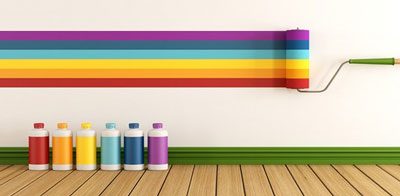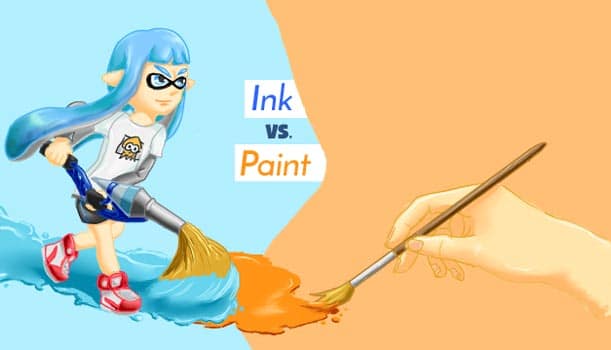Ink Vs. Paint – Detailed Comparison Between Them
Although ink and paint come under the same category in the world of fine arts, they differ from each other from various perspectives.
We primarily use ink to write. On the other hand, paint is used for giving colors. Their different characteristics help us in different ways.
This article is going to be about a detailed comparison between these two elements, and tell which one you should use at what circumstances.
Table of Contents
Characteristics of Ink and Its Usage
Ink is mostly made of dyes. It's pigmented but in a dissolved form. You can refer to it as a solution as well.
It’s used for printing, writing, and general day to day purposes in most cases.
You will see that the flow of ink is much thinner compared to paint, it's almost like water. If you know how a pen does writing on paper, you will understand why ink is so thinner.
Whether it’s a ballpoint pen or a fountain pen, the ink must make its way to flow through the barrel effortlessly. If the ink is too thick, it will cause a ball pen or nib tip to clog.
As a result, the pen will be useless. That’s the reason why the ink must be thin enough to flow out without any issue.
If a thicker solution manages to flow out of the barrel, it will require more effort from the writer and cause hand fatigue for an extended period of writing.
When you write something on a surface using ink, natural elements such as water and UV lights can cause the writing to diminish. So, by default, inks do not make permanent markings.
However, you can still make ink to produce permanent writings if the solution is mixed with varnish or protectant. Such a solution of ink can preserve writings on the surface regardless of the elements.
People widely use pigment-based inks in printing presses. These inks are more similar to water. Silkscreen printing such as t-shirts, bags, hats, etc. are primarily designed using ink.
Ingredients of Ink
These are the most commonly used terms and elements related to ink –
- Pigment: It’s a type of colorant that doesn’t dissolve easily.
- Dye: Colorant that dissolves in water without any additional help.
- Additive: The substance that prevents ink from drying out. It also ensures that the ink doesn't separate over time. For example, edible ink has additives that prevent it from spoiling.
- Colorant: It’s a type of dye or pigment that gives color to materials.
- Drying Agent: It helps the ink to dry once it contacts the surface like paper.
- Insoluble: Materials or ingredients that don't completely dissolve in substances like water.
- Linseed Oil: Almost a colorless oil extracted from dried, ripened seeds of the flax plant.
- Soluble: The term that addresses substances that dissolve within a liquid.
- Vehicle: The binding agent used for dissolving pigment within a solvent.
- Wax: Substance that doesn’t let the ink rub off the surface.
Types of Ink
Primarily, inks are of two kinds:
Pigment Ink
Pigments are composed of various solid matter such as rocks, metals, minerals, charcoal, etc. A powdery talc texture is made out of these matters. This pigment powder is mixed with a carrier or vehicle to produce ink or paint.
These inks are insoluble, and you will find the presence of raw particles within it.
Even though pigment inks are water-resistant, they have some drawbacks as well. It's more challenging to write and print with pigment inks as they don’t completely dissolve in water.
Furthermore, these inks are expensive and don't have the same level of color vibrancy and brightness compared to other types of ink.
Even though it produces less bright color, it’s less likely to fade away and is more durable ink.
Pigment inks are commonly used in paints, inks, rubber, and plastic.
Dye Ink
This type is usually used in fountain pens and gel pens. Dye inks are not as permanent as pigment inks. The ink easily gets smear when it contacts with water in wet state, and fades much faster than pigment ink.
Dye inks are cheaper and produce more bright colors compared to pigment inks. However, most of the artists still prefer pigment inks because they don’t fade so easily. These inks can be both synthetic and natural.
They mostly used in inks, textiles, and food additives.
Characteristics of Paint and Its Usage
Unlike ink, paints don't dissolve into any solution and turn into a water-like form. Preferably, colors are made by adding synthetic or natural pigment to a medium such as a linseed oil or gum arabic. The intermediary mediums, later on, help to carry the pigment to the painted surface.
Paints don't penetrate to the surface; instead, they rest on the top of the painting surface. Once the painting is done, you cannot scrape or peel it off. The pigments are trapped in the weavings of that surface.
Brushes or palette knives are the tools that you need have to use paints.
Ingredients of Paint
Commonly used ingredients of paint are –
- Pigment: Generally, pigments are of two types; prime pigments, and extender pigments. Mostly, the prime pigments are used in paints. This component imparts color and opacity to the paint.
- Binder: Binder, also known as resin. It’s a polymer that forms matrix in order to hold the pigment in place.
- Extender: The large pigment particles that improve adhesion, save binder, and strengthen the film.
- Solvent: Also known as thinner. Solvent is used to reduce paint’s viscosity to ensure better application. It also acts as a carrier for both resin and pigments.
- Additives: Additives are used for modifying the properties of dry film and liquid paint. It makes the paint easy to brush, mold resistant, scuff resistant, and sag resistant.
Types of Paints

We can categories paints into the following sections based on their characteristics.
Water-Based Paints
Most of the wall paints today are water-based ones. These paints are easy to use, but you have careful be if your walls had oil-based coats previously. In such cases, you need to roughen the surface with medium to smooth grit sandpaper and then approach for the water-based coating.
Water-based paints don't require pre-treatment for coating. It doesn't allow the mildew to grow and has a low level of toxic emissions. The paint dries quickly, and you can easily clean it up with water. Its color gets more stable over-time on almost all surfaces and doesn't get fade or yellowish in sunlight.
Oil-Based Paints
Like water-based paints, you can also use oil-based paints on almost all surfaces. The color has a well-reputation of being highly durable and providing a luxurious finish. However, it emits a strong scent which you cannot wash it away with water.
Oil-paints make the surface glossy. It's durable for rooms with high moisture. However, the paint takes longer to dry.
Paint Finishes
These types of paints are well-known for their velvety texture. Coatings smartly hide imperfections of the surface (walls and ceilings). If you want good color depth on your walls, this is the paint to choose from. In most cases, it's considered as the standard sheen for walls.
A significant drawback is that the painted surface is challenging to clean.
Eggshell and Stain Paint
Eggshell paint finish feels excellent to touch. Stain finish feels the same but looks glossier than eggshell. Both of these paints are suitable for durability and reflectivity.
Semi-Gloss and Gloss Paint
These paints provide great reflective sheens. It suits best for doors, window trim, kitchens, bathrooms, moldings, baseboards, and accent walls. You will find the paint durable enough even after multiple cleanings.
Key Differences Between Ink and Paint
The differences between these two elements are quite simple and straight forward.
Coloring Properties
The coloring agents of ink and paint are different. Colored minerals such as talc and clays are used for making paints.
On the other hand, inks are made by dissolving tannic acid and iron sulfate either in water or alcohol. Many inks include dyes in the form of aniline.
Coloring Procedures
When you write anything using ink, it soaks into the surface.
But this is not the case with paints; they cover the surface with coating. Before painting begins, a primer is applied onto the surface. That’s why paint chips off the surface, where it doesn’t happen with the ink.
Surface Protection
Paint provides the surface with a protective coating which prevents it from deteriorating when elements such as rain and wind assail.
However, you get no such protection with inks.
The Surface of Ink and Paint
Although no one will bother you to use paint and ink on the same surface, there are some specific surfaces for both these color agents.
As inks are thinner than paints, the ideal surface for inks would be the one with lower lbs or gsm. Inks won't bleed, so there's no concern for thicker coating here.
But when it comes to using inks liberally, you can get a thicker surface.
For paints, you will require an even thicker surface than inks, whether it's acrylic or oil paint. The sheer weight of the pigment goes much better when the surface is thicker.
Besides, most paints do a great job on canvas and natural materials as well.
Final Words
Having their way of beautifying a surface, both ink and paint serve professional and general purposes quite well.
After going through the article, I hope that now you have a clear understanding of both the elements.

